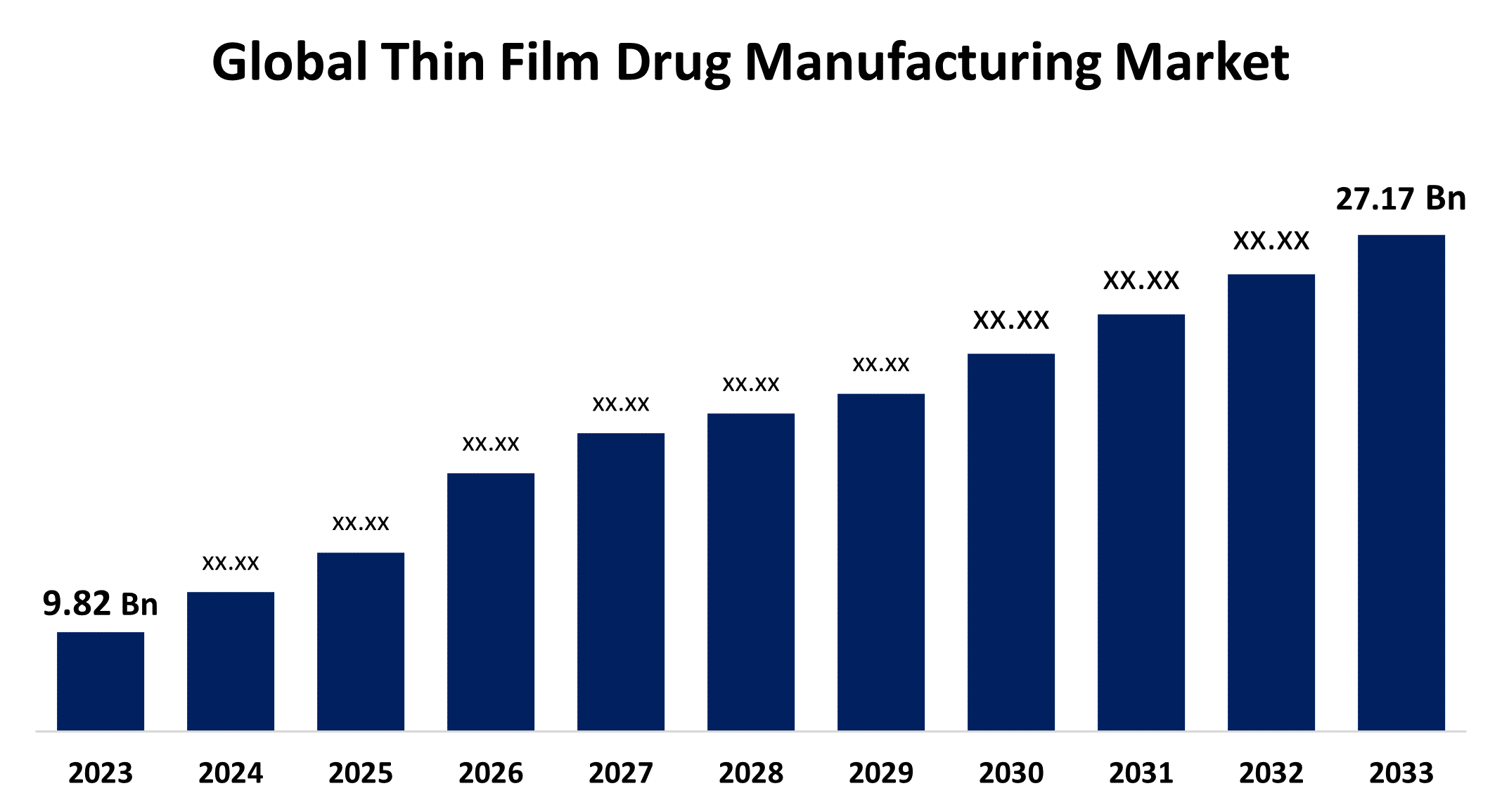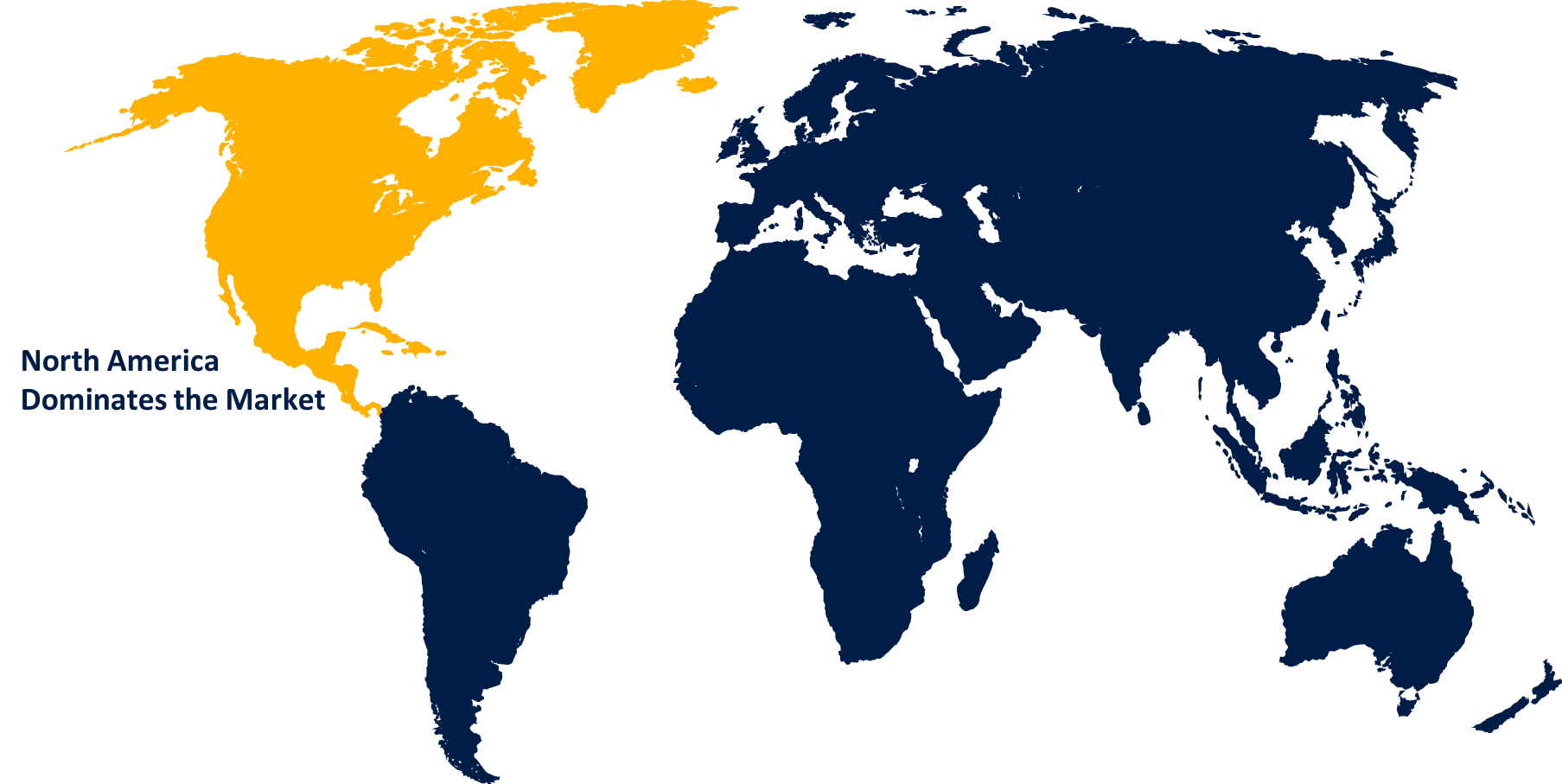Global Thin Film Drug Manufacturing Market Size, Share, and COVID-19 Impact Analysis, By Product (Oral Thin Film, Transdermal Thin Film, and Others), By Indication (Schizophrenia, Migraine, and Opioid Dependence), and By Region (North America, Europe, Asia-Pacific, Latin America, Middle East, and Africa), Analysis and Forecast 2023 - 2033
Industry: HealthcareGlobal Thin Film Drug Manufacturing Market Insights Forecasts to 2033
- The Global Thin Film Drug Manufacturing Market Size was Valued at USD 9.82 Billion in 2023
- The Market Size is Growing at a CAGR of 10.71% from 2023 to 2033
- The Worldwide Thin Film Drug Manufacturing Market Size is Expected to Reach USD 27.17 Billion by 2033
- Asia Pacific is Expected to Grow the fastest during the forecast period.

Get more details on this report -
The Global Thin Film Drug Manufacturing Market Size is Anticipated to Exceed USD 27.17 Billion by 2033, Growing at a CAGR of 10.71% from 2023 to 2033.
Market Overview
A new method of drug delivery involves the use of thin, flexible films or oral drug strips to administer medications, known as thin film drugs. These drugs dissolve quickly in the mouth, allowing active ingredients to enter the bloodstream through the buccal membranes in the cheeks and can also be absorbed in the small intestines. Thin film drugs are effective in treating various conditions such as nausea, pain, cough, cold, motion sickness, bronchitis, asthma, and more, and are suitable for pediatric, geriatric, and psychiatric patients. They provide an expedient and easy administration method, particularly beneficial for individuals with mobility issues or those continually on the move, and also offer a discreet and non-invasive way to take medication.
According to the U.S. National Institutes of Health, the oral thin film represents a groundbreaking trend, prompting pharmaceutical companies in this area to persist in their efforts to modify their medications across various categories to contain this technology. This innovative drug delivery system is particularly beneficial for patients with swallowing difficulties, especially children and older adults, offering numerous advantages over other forms of medication, including enhanced bioavailability and faster onset of action. It is a vital oral dosage form for emergency situations and when immediate effects are essential, making the oral thin film a promising option with exceptional patient compliance and many benefits.
Report Coverage
This research report categorizes the market for thin film drug manufacturing based on various segments and regions forecasts revenue growth and analyzes trends in each submarket. The report analyses the key growth drivers, opportunities, and challenges influencing the thin film drug manufacturing market. Recent market developments and competitive strategies such as expansion, product launch, and development, partnership, merger, and acquisition have been included to draw the competitive landscape in the market. The report strategically identifies and profiles the key market players and analyses their core competencies in each sub-segment of the thin film drug manufacturing market.
Global Thin Film Drug Manufacturing Market Report Coverage
| Report Coverage | Details |
|---|---|
| Base Year: | 2023 |
| Market Size in 2023: | USD 9.82 Billion |
| Forecast Period: | 2023-2033 |
| Forecast Period CAGR 2023-2033 : | 10.71% |
| 2033 Value Projection: | USD 27.17 Billion |
| Historical Data for: | 2019-2022 |
| No. of Pages: | 215 |
| Tables, Charts & Figures: | 110 |
| Segments covered: | By Product, By Indication, By Region |
| Companies covered:: | Pfizer, Inc., Novartis AG, Wolters Kluwer, Solvay, AbbVie, Sumitomo Pharma Co., Ltd, IntelGenx Corp., NAL Pharma, ZIM Laboratories Limited, Indivior PLC, MonoSol, and Others Key Vendors. |
| Pitfalls & Challenges: | COVID-19 Empact,Challenges, Future, Growth, & Analysis |
Get more details on this report -
Driving Factors
There are various factors that drive the market; one of the factors is advancements in this novel drug delivery. Various companies around the globe are focusing on investment in this promising form of drug delivery owing to a rise in recognition. Key startup companies are particularly focusing on thin-film drug delivery routes for cannabis-based drugs. Additionally, the rise in the regulatory approvals for thin film drugs for various disease indications is propelling the growth of the market. The rising acceptance of thin-film therapeutics among the older population of the world is increasing due to the ease of administration of such therapeutics. As a result, key players are also focusing on these drug delivery methods for diseases such as Parkinson’s and Alzheimer’s predominant in the geriatric population. Hence, an increase in the geriatric population worldwide could greatly benefit the market's growth in the upcoming years.
Restraining Factors
There are numerous factors that can hinder the thin film drug manufacturing market, including. The complex manufacturing processes for oral thin films involve advanced equipment, expertise, and quality control. The cost and complexity of manufacturing can bind the availability and affordability of oral thin films. Oral thin films can only carry a small medication load of 10 to 20 mg. Oral thin films are more vulnerable to humidity and temperature due to their larger surface area. The high cost of developing thin-film drugs limits research and implementation in developing countries.
Market Segmentation
The thin film drug manufacturing market share is classified into product and indication.
- The oral thin film segment is estimated to hold the highest market revenue share through the projected period.
Based on the product, the thin film drug manufacturing market is classified into oral thin film, transdermal thin film, and others. Among these, the oral thin film segment is estimated to hold the highest market revenue share through the projected period. The innovative delivery method of oral thin film films improves patient compliance and convenience due to their quick dissolution on the tongue, allowing for rapid absorption of active ingredients. This benefit is particularly valuable for patients who struggle to swallow pills or need fast-acting medications. Furthermore, advancements in formulation technologies improve the taste and stability of these films, making them more appealing to consumers. As healthcare trends prioritize patient-centric solutions and non-invasive administration methods, the demand for oral thin films is expected to significantly increase in the projected period.
- The schizophrenia segment is anticipated to hold the largest market share through the forecast period.
Based on the indication, the thin film drug manufacturing market is divided into schizophrenia, migraine, and opioid dependence. Among these, the schizophrenia segment is anticipated to hold the largest market share through the forecast period. This is driven by the disorder's increasing prevalence and the growing awareness of mental health issues. As research progresses and new treatment options emerge, there is a heightened focus on innovative therapies, including atypical antipsychotics and long-acting injectables, which improve patient adherence and outcomes. Additionally, the rising investments in mental health initiatives and the destigmatization of mental illness are leading to more patients seeking treatment, making the schizophrenia segment a significant focus for pharmaceutical companies and healthcare providers alike.
Regional Segment Analysis of the Thin Film Drug Manufacturing Market
- North America (U.S., Canada, Mexico)
- Europe (Germany, France, U.K., Italy, Spain, Rest of Europe)
- Asia-Pacific (China, Japan, India, Rest of APAC)
- South America (Brazil and the Rest of South America)
- The Middle East and Africa (UAE, South Africa, Rest of MEA)
North America is anticipated to hold the largest share of the thin film drug manufacturing market over the predicted timeframe.

Get more details on this report -
North America is anticipated to hold the largest share of the thin film drug manufacturing market over the predicted timeframe. North America benefits from a strong healthcare infrastructure, significant investment in research and development, and a strong presence of leading pharmaceutical companies. The rising prevalence of chronic diseases and a growing emphasis on patient-centric drug delivery systems are driving demand for innovative formulations like oral thin films. Regulatory support and a favorable reimbursement landscape further enhance market growth, positioning North America as a critical hub for advancements in thin film drug technology, allowing the region to lead the market throughout the forecast period.
Asia Pacific is expected to grow at the fastest CAGR growth of the thin film drug manufacturing market during the forecast period. The region experiences a surge in chronic diseases, which drives the need for innovative treatment options that enhance patient compliance, such as oral thin films, due to a combination of rapidly expanding healthcare infrastructure, increasing investments in pharmaceutical research, and rising demand for advanced drug delivery systems. Additionally, growing awareness of mental health issues and the adoption of modern therapeutic approaches contribute to market expansion. The presence of a large population, coupled with rising disposable incomes and improving access to healthcare services, positions Asia Pacific as a dynamic and promising market for thin film drug manufacturing.
Competitive Analysis:
The report offers the appropriate analysis of the key organizations/companies involved within the thin film drug manufacturing market along with a comparative evaluation primarily based on their product offering, business overviews, geographic presence, enterprise strategies, segment market share, and SWOT analysis. The report also provides an elaborative analysis focusing on the current news and developments of the companies, which includes product development, innovations, joint ventures, partnerships, mergers & acquisitions, strategic alliances, and others. This allows for the evaluation of the overall competition within the market.
List of Key Companies
- Pfizer, Inc.
- Novartis AG
- Wolters Kluwer
- Solvay
- AbbVie
- Sumitomo Pharma Co., Ltd
- IntelGenx Corp.
- NAL Pharma
- ZIM Laboratories Limited
- Indivior PLC
- MonoSol
- Others
Key Target Audience
- Market Players
- Investors
- End-users
- Government Authorities
- Consulting And Research Firm
- Venture capitalists
- Value-Added Resellers (VARs)
Recent Developments
- In August 2024, atai Life Sciences which is a clinical-stage biopharmaceutical company with the goal of revolutionizing the treatment of mental health disorders, reported encouraging initial findings from the Phase 1b study of VLS-01, its specialized oral transmucosal film containing N,N-dimethyltryptamine (DMT) that is administered on the buccal surface.
- In April 2024, Diazepam (Libervant Buccal Film; Aquestive Therapeutics) has been granted approval by the FDA for the treatment of occasional, repetitive episodes of frequent seizure activity, like seizure clusters or acute repetitive seizures, in children between the ages of 2 and 5.
Market Segment
This study forecasts revenue at global, regional, and country levels from 2023 to 2033. Spherical Insights has segmented the thin film drug manufacturing market based on the below-mentioned segments:
Global Thin Film Drug Manufacturing Market, By Product
- Oral Thin Film
- Transdermal Thin Film
- Others
Global Thin Film Drug Manufacturing Market, By Indication
- Schizophrenia
- Migraine
- Opioid Dependence
Global Thin Film Drug Manufacturing Market, By Regional Analysis
- North America
- US
- Canada
- Mexico
- Europe
- Germany
- UK
- France
- Italy
- Spain
- Russia
- Rest of Europe
- Asia Pacific
- China
- Japan
- India
- South Korea
- Australia
- Rest of Asia Pacific
- South America
- Brazil
- Argentina
- Rest of South America
- Middle East & Africa
- UAE
- Saudi Arabia
- Qatar
- South Africa
- Rest of the Middle East & Africa
Frequently Asked Questions (FAQ)
-
1. What is the CAGR of the thin film drug manufacturing market over the forecast period?The thin film drug manufacturing market is projected to expand at a CAGR of 10.71% during the forecast period.
-
2. What is the market size of the thin film drug manufacturing market?The Global Thin Film Drug Manufacturing Market Size is Expected to Grow from USD 9.82 Billion in 2023 to USD 27.17 Billion by 2033, at a CAGR of 10.71% during the forecast period 2023-2033.
-
3. Which region holds the largest share of the thin film drug manufacturing market?North America is anticipated to hold the largest share of the thin film drug manufacturing market over the predicted timeframe.
Need help to buy this report?